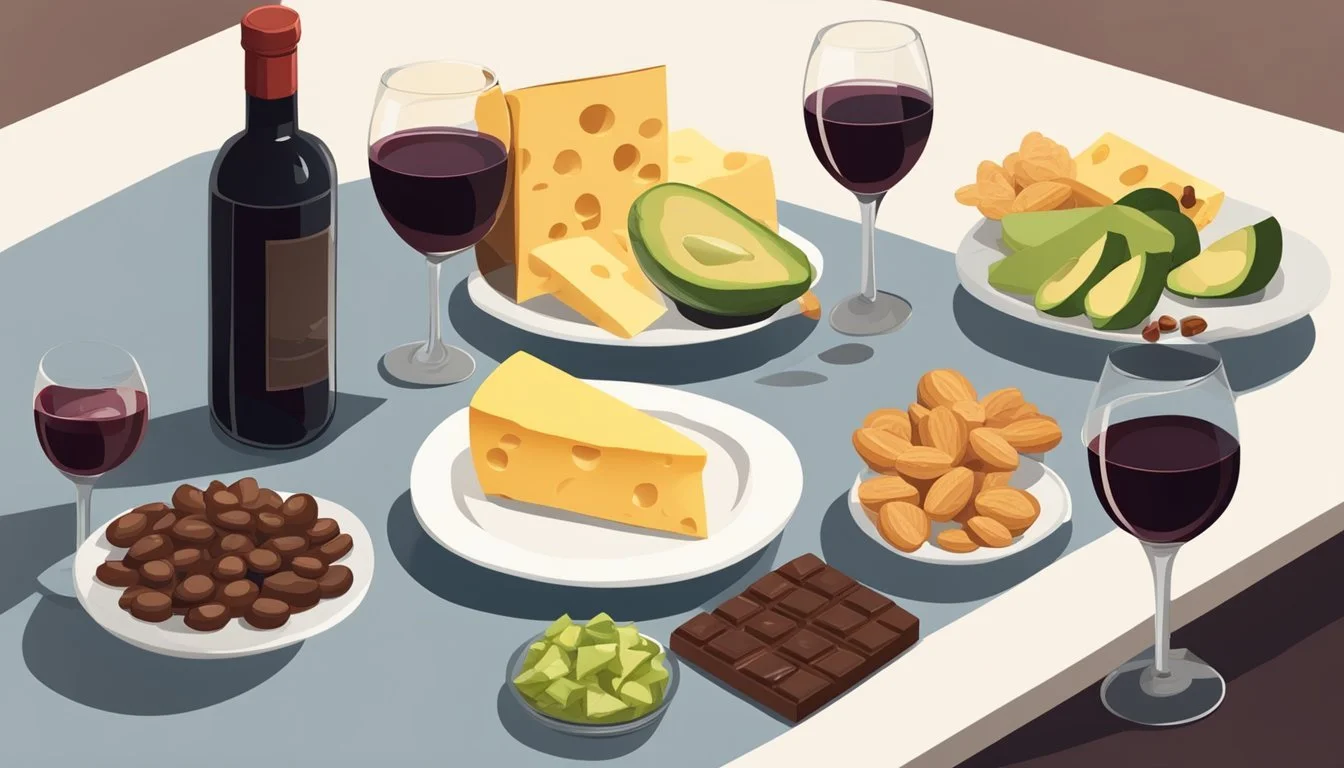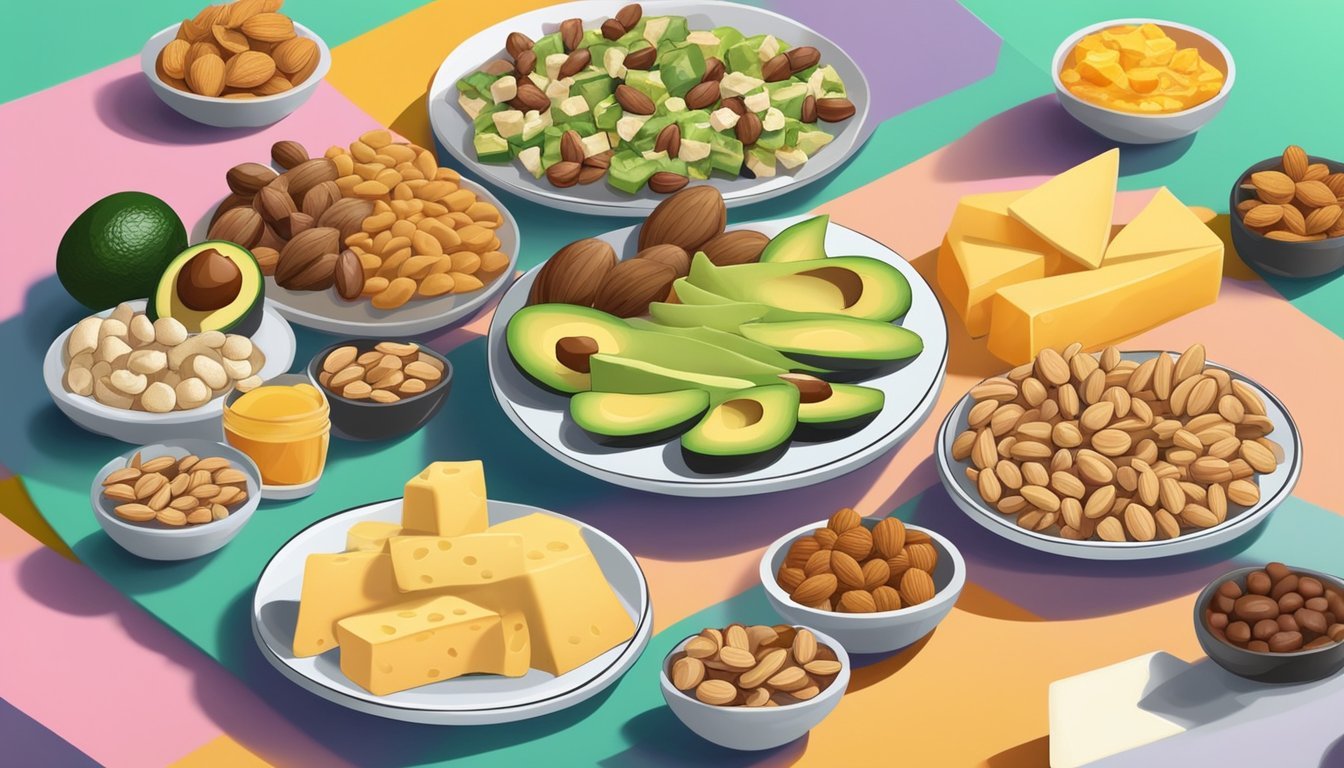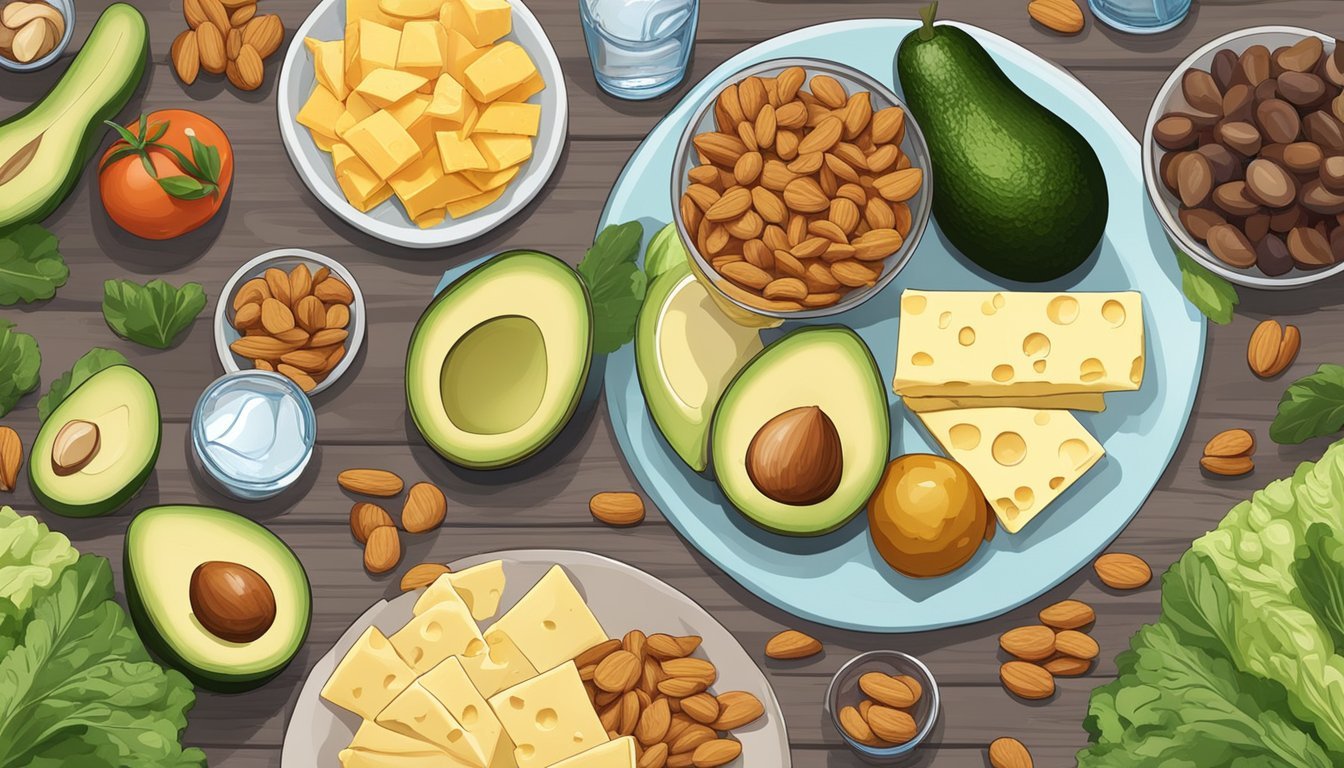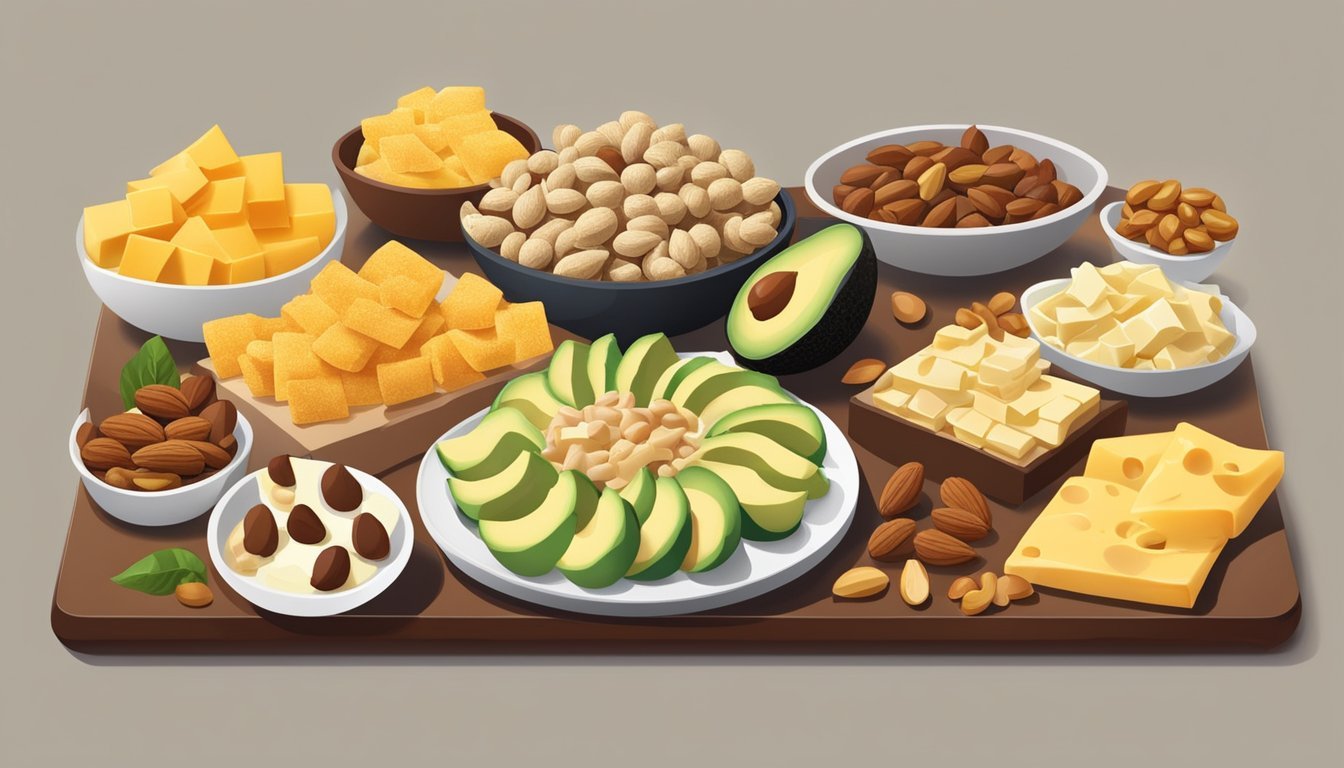High-Fat Diet Snacks
Satiating Choices for Health-Conscious Individuals
High-fat foods have long carried a reputation for being unhealthy, but in moderation, certain high-fat snacks (What wine goes well with snacks?) can offer both satiety and health benefits. Snacks high in healthy fats can be particularly effective at curbing hunger between meals because fats are more energy-dense and take longer to digest than carbohydrates or proteins. This slow digestion process provides a sustained feeling of fullness, which can help reduce overall calorie intake by keeping snacking at bay.
Many healthy high-fat snacks also contain other important nutrients, such as proteins and fibers, that contribute to the feeling of satiation. For example, nuts (What wine goes well with nuts?) are not only high in fat but are also a good source of fiber and protein, making them an ideal snack for weight management. Similarly, adding natural nut butters (how long does butter last?) to celery sticks, commonly known as 'ants on a log', transforms a simple vegetable into a satisfying snack with a balance of fat and crunchy texture.
Choosing snacks that are high in beneficial fats, like monounsaturated and polyunsaturated fats, supports heart health and provides essential fatty acids that the body can't produce on its own. Avocados (how long does avocado last?), olives, and certain seeds are prime examples of whole food snacks that offer these fats. Incorporating such nutrient-dense snacks into a diet can help maintain energy levels throughout the day while aligning with healthful eating practices.
Understanding High-Fat Diets
High-fat diets have gained attention for their potential in weight management and metabolic health. They often focus on the inclusion of fats that are beneficial for long-term health.
Benefits of High-Fat Snacks
High-fat snacks can provide prolonged satiety, helping individuals feel full for longer periods and potentially reducing overall calorie intake. Healthy fats, such as omega-3 fatty acids found in some seeds and fish, contribute to heart health and can support cognitive functions.
Incorporating snacks with monounsaturated and polyunsaturated fats can supply essential fatty acids that the body cannot make on its own. These fats are crucial for building cell membranes and various hormones.
Difference Between Saturated and Unsaturated Fats
It's important to distinguish between the types of fats when considering a high-fat diet:
Saturated Fats: Typically found in animal products and processed foods, these fats are solid at room temperature. Excessive consumption can lead to increased LDL cholesterol levels, which is linked to a higher risk of heart disease.
Unsaturated Fats: These are generally liquid at room temperature and can be divided into:
Monounsaturated fats: These fats are present in olive oil, avocados, and certain nuts, offering benefits such as heart health and reduced inflammation.
Polyunsaturated fats: This category includes omega-3 fatty acids, which are found in fatty fish, flaxseeds, and walnuts, and are associated with numerous health benefits, including support for brain health and joint mobility.
Careful consideration of fat sources ensures a balanced approach to high-fat snacking, optimizing nutrition and health benefits.
Nutrient-Dense Fat Sources
In selecting high-fat snacks, one should consider foods that offer additional nutritional benefits, such as vitamins, minerals, and antioxidants. Nutrient-dense fat sources not only provide energy but also support overall health.
Nuts and Seeds
Nuts such as almonds and walnuts are excellent snacks that pack a punch in terms of healthful fats, protein, and fiber. They are rich in omega-3 fatty acids, which are known for their anti-inflammatory properties. Seeds like chia and flaxseeds offer similar nutritional profiles and are loaded with both fiber and protein, making them a satiating choice.
Almonds: Vitamin E, magnesium
Walnuts: Alpha-linolenic acid (ALA), a plant-based omega-3
Dairy Products
Full-fat dairy products contain a well-rounded nutritional profile, including calcium and often fortified with vitamin D. Cheese, particularly, is a calorie-dense snack that provides both protein and fat. Yogurt, especially Greek yogurt, is another dairy product that can be incorporated into a high-fat diet, offering probiotics for digestive health.
Cheese: High in fat, protein, and calcium
Yogurt: Probiotics, potential vitamin D fortification
Oils and Butters
Healthy oils like olive oil are a staple in diets known for heart-health benefits, such as the Mediterranean diet. They are high in monounsaturated fats. Butters and nut butters, like peanut butter, offer a smooth texture and a filling combination of fat and protein. When choosing nut butters, one should look for varieties without added sugars and oils to maximize the health benefits.
Olive Oil: Monounsaturated fats, antioxidants
Nut Butters (Peanut Butter): Protein, healthy fats
Healthy Snacking Habits
Healthy snacking habits can enhance weight loss and nutrition by keeping calorie intake in check and ensuring a balance of protein, fiber, and healthy fats. Strategic timing and portion control play pivotal roles in maintaining these habits.
Balancing Macros in Snacks
When selecting snacks, one should aim for a balance of macronutrients. Protein is essential for satiety and muscle repair, fiber is important for digestive health and also helps to keep one feeling full, and healthy fats contribute to overall satisfaction and can provide a sustained energy source. For example, nuts offer a mix of these macronutrients, making them an excellent snack choice.
Protein sources: Greek yogurt, lean meats, eggs
Fiber sources: Vegetables, fruits like apple slices, and whole grains
Healthy fats sources: Avocado, cheese, and seeds
Portion Control
Adhering to portion control ensures one does not consume excessive calories which can negate the benefits of snacking. A handful of nuts, such as almonds, translates to roughly a one-ounce serving, providing a calorie-controlled snack that's high in nutrients such as vitamins and minerals, while managing cholesterol levels.
Snack Options:
Almonds
Serving Size: 1 ounce (23 nuts)
Calories (approx.): 164
Greek yogurt
Serving Size: 1 cup
Calories (approx.): 100-120
Serving Size: 1/2 medium
Calories (approx.): 120
Timing Your Snacks
Snacking is not just about what one eats, but also when. Those aiming for weight loss or better dietary patterns should plan their snacks to manage hunger between meals. A mid-morning snack might include a protein-rich food, while an afternoon snack could be richer in fiber, aiding in continued fullness until dinner. This helps prevent overeating at meal times and stabilizes blood sugar levels throughout the day.
Suggested Snacks by Time of Day:
Mid-Morning
Greek yogurt with berries
Macronutrient Focus: Protein and fiber
Afternoon
Vegetable sticks with hummus
Macronutrient Focus: Fiber and protein
Early Evening
Macronutrient Focus: Fiber and healthy fats
High-Fat Snack Recipes And Ideas
High-fat snacks are essential for those following a ketogenic diet or looking to stay satiated for longer periods. These ideas ensure a balance of taste and nutrition with an emphasis on wholesome fats.
Savory Snack Ideas
Cheese: An excellent source of calcium and protein, cheese can be eaten alone or paired with vegetables like cherry tomatoes or cucumber slices. For a portable snack, one might consider cheese sticks or cubes.
Avocado and Hummus: Mashing avocado and blending it with hummus makes for a creamy dip high in healthy fats and fiber. Serve it with a selection of cut vegetables or whole-grain crackers.
Nuts and Seeds: A handful of nuts like almonds, walnuts, or a homemade trail mix can provide a quick, nutrient-dense snack. Opt for raw or dry roasted varieties to avoid excess oil and salt.
Eggs: Hard-boiled eggs are a compact snack rich in fats, protein, and vitamins. They can be prepared in advance and seasoned with a pinch of salt and herbs.
Sweet Snack Ideas
Berries and Cream: Berries like strawberries and blueberries offer antioxidants and can be served with full-fat cream for a hint of indulgence without high levels of sugar.
Fruit and Nut Butter: Slices of apple or pear paired with almond or tahini butter create a fulfilling snack that combines natural sugars with healthy fats.
Chocolate Peanut Butter Cream Cheese Fat Bombs: Mix cream cheese with natural peanut butter and cocoa powder, sweeten with a non-sugar substitute, and form into small balls for an energy-dense treat.
Keto Chocolate Pots: Incorporating a high-fat content, these desserts blend melted dark chocolate with full-fat coconut milk and a sweetener of choice, chilled and served in small cups.
Fitting High-Fat Snacks into Specific Diets
When incorporating high-fat snacks into one's diet, considering the nutritional value and dietary restrictions is crucial. Tailoring snack choices to meet the guidelines of specific diets ensures individuals achieve their health goals while enjoying satisfying treats.
Keto and Low-Carb Options
In a ketogenic or low-carb diet, the aim is to minimize carbohydrate intake while focusing on high-fat and moderate-protein foods. These diets turn fats into the primary source of energy, aiming for ketosis—a state wherein the body efficiently burns fat for fuel.
Cheese: A serving of hard cheeses like cheddar or gouda offers a quick, keto-friendly snack that's rich in fat and low in carbs.
Nuts and Seeds: Almonds, macadamias, and chia seeds are excellent choices providing healthy fats, protein, and fiber.
Olives and avocados are other nutrient-dense snacks that fit perfectly into a keto or low-carb diet, delivering both essential fats and a range of vitamins and minerals.
List 1: Keto-Friendly High-Fat Snacks
High in saturated fats and fiber; a crunchy, low-carb option.
Packed with protein and fats; virtually zero carbs.
Vegetarian and Vegan Choices
Vegetarian and vegan diets exclude meat and, for vegans, all animal products. Individuals following these diets should prioritize snacks that are not only high in healthy fats but also align with their ethical and dietary principles.
Nuts and Nut Butters: Cashews, almonds, and peanut butter can be great sources of fats and proteins for vegetarians and vegans alike.
Seeds: Flaxseeds, sunflower seeds, and pumpkin seeds provide omega-3 fatty acids and other essential nutrients.
For vegans, incorporating whole grain options such as whole grain crackers paired with guacamole can add both satisfying fats and valuable fiber to the diet. Coconut-based snacks are also a staple in vegan diets for their rich texture and good fat content.
List 2: Vegetarian and Vegan High-Fat Snacks
Avocado Toast
A slice of whole grain bread topped with smashed avocado.
Dark Chocolate
Contains cocoa butter, a good source of fat for vegans.
In summary, whether following a keto, vegetarian, or vegan lifestyle, individuals have a variety of high-fat snack options that can keep them satisfied and within the boundaries of their dietary preferences.
Shopping and Storage Tips
When selecting high-fat diet snacks, one should prioritize not only nutrition but also the quality and longevity of their food choices. Ensuring items are stored properly maintains their health benefits and taste, while savvy shopping can lead to financial savings without compromising on quality.
Selecting Quality Ingredients
When shopping for healthy snacks high in fats, focus on items rich in fat-soluble vitamins like avocados, which are high in Vitamin E, or nuts, which have Vitamin K. For snacks with a balance of fat and other nutrients, pick options that also provide B vitamins, important for energy metabolism. Keep an eye out for:
Fresh avocados: should be firm yet give slightly under pressure.
Nuts and seeds: choose raw or dry-roasted varieties without added sugars.
Storing for Freshness
To maintain freshness and nutrient integrity, proper storage of snacks is key. Store nuts and seeds in air-tight containers in a cool, dark place to prevent rancidity. Refrigerate items like cheeses and yogurts to preserve their taste and B vitamin content. Implementing these storage tips helps one derive maximum satisfaction and health benefits:
Nuts and seeds: Use clear, airtight containers and label with purchase dates.
Dairy products: Monitor expiry dates and keep at the back of the fridge where temperature fluctuations are minimal.
Budget-Friendly Buying
High-fat, nutrient-dense snacks can be budget-friendly if one shops smartly. Bulk-buying non-perishable items such as nuts can reduce costs significantly. Moreover, opting for store brands or sale items can provide similar nutritional benefits as more expensive brands. Here are some tactics to consider:
Compare unit prices to get the best deal per ounce or gram.
Check for discounts or loyalty programs in local stores for additional savings.
Nutrition and Health Considerations
When considering high-fat snacks as part of a diet, it is essential to understand their impact on cholesterol levels, glycemic load, and overall heart health to make informed choices that benefit long-term well-being.
Managing Cholesterol Levels
Incorporating snacks with healthy fats can influence cholesterol levels. Specifically, monounsaturated and polyunsaturated fats, found in nuts like pistachios, almonds, and walnuts, are linked to improved HDL cholesterol levels. It's crucial to choose fats wisely, as they can have different effects on the lipid profile. High-fat snacks that emphasize omega-3 fatty acids, for example, are beneficial because they may reduce the risk of heart disease.
Understanding Glycemic Impact
High-fat snacks can have a low glycemic impact, minimizing spikes in blood sugar levels. Foods high in fiber, such as nuts and cheese, have a slow digestive process, resulting in a more gradual release of sugar into the bloodstream. This management of blood sugar can be favorable for overall health, especially for individuals who have diabetes or are monitoring their carbohydrate intake.
Heart Health
A snack's fat composition is instrumental in influencing heart health. Snacks that include omega-3 fatty acids, present in certain nuts and seeds, contribute to cardiovascular health by reducing arterial inflammation and potentially lowering the risk of heart disease. Balance is vital; the inclusion of both monounsaturated and polyunsaturated fats in a snack can help to support heart health and promote overall nutritional well-being.
Conclusion
Incorporating high-fat snacks into one's diet can offer a satisfying way to manage hunger and support weight management goals. Healthy fats, found in foods like nuts, seeds, and dairy, play a crucial role in satiety, helping individuals feel full for longer periods. This in turn may aid in reducing overall caloric intake without compromising nutritional value.
A strategic approach to snacking might include selecting snacks that contain a balance of fats, protein, and carbohydrates. Options such as yogurt, cheese, and avocados offer high-quality protein and fats that are beneficial for both satiety and nutrition. Consider these common high-fat snacks:
Nuts and seeds: A source of healthy fats, fiber, and protein.
Avocado: Rich in monounsaturated fats and fiber.
Greek yogurt: Combines high-quality protein with beneficial fats.
Cheese: Offers a satisfying blend of fat and protein.
When individuals consume snacks with sufficient dietary fat, they may experience a reduction in hunger signals and avoid overeating during meal times. As research suggests, this can be an effective component of a weight management plan. It is, however, important to be mindful of portion sizes to ensure that total calorie intake remains in line with one's weight loss or maintenance goals.
Finding the right balance in one's diet can be a personal journey. It entails understanding how different foods interact with one's metabolism and sense of fullness. A diet that includes healthy high-fat snacks can be a versatile and flavorful way to enhance dietary satisfaction while also fostering the potential to lose weight effectively.








